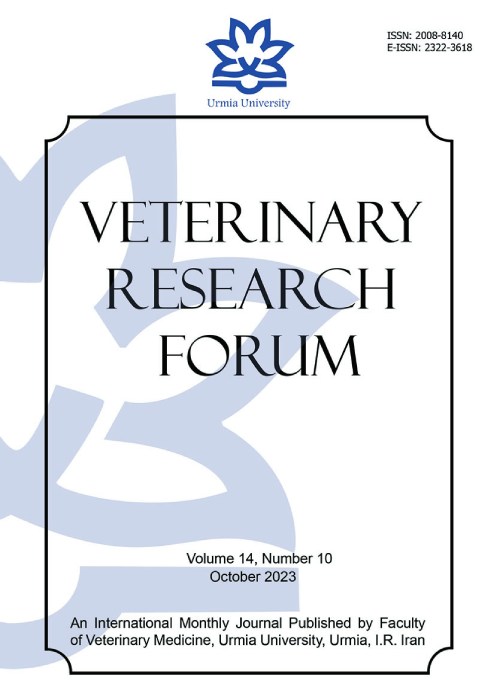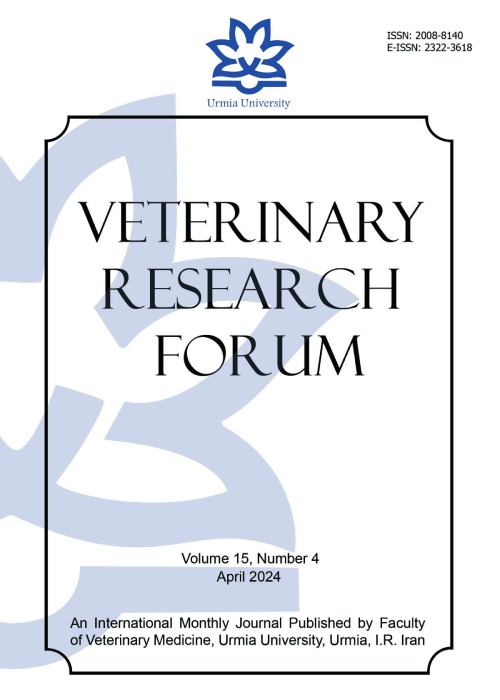فهرست مطالب

Veterinary Research Forum
Volume:14 Issue: 10, Oct 2023
- تاریخ انتشار: 1402/07/09
- تعداد عناوین: 8
-
-
Pages 525-530The different microorganisms that make up the normal microbiota of birds can be present in different substrates such as the soil and other elements that make up the habitat. In the case of the cattle egret, the intestinal microbiota can change due to partially migratory habits. Thus, this study aimed to isolate and identified fungi and yeasts with zoonotic potential obtained from cattle egret (Bubulcus ibis) droppings settler in Tulancingo, Hidalgo, at Eastern economic zone of Mexico. Cattle egret droppings were collected for analysis, a total of 240 pool samples, which were spread on Sabouraud agar and incubated at 25.00 - 37.00 ˚C for 2 to 3 days. Filamentous fungi and yeast were identified by morphology and Lactophenol Blue staining or Chinese Ink stains. Filamentous fungi genera Mucor spp. (42.35%), Rhizopus spp. (26.71%); Penicillium spp. (13.35%); Paecilomyces spp. (11.40%); Scedosporium spp. (1.95%); and, from yeasts such as Cryptococcus spp. (2.29%); Rhodotorula spp. (1.95%) were identified. In this work, the presence of filamentous fungi genera and yeasts with zoonotic potential were isolated from droppings of cattle egret. The clinical presentation of fungal infections in humans can occur when immunosuppression is present or different predisposition factors are conjugated. The presence of birds and their dropping in anthropogenic activities is not a predisposing factor for the presentation of the disease in immunologically competent humans.Keywords: feces, Fungus, Microbiology
-
Pages 531-539The jaagsiekte sheep retrovirus (JSRV), belonging to the betaretrovirus genus of the retroviridae family, includes both exogenous and endogenous jaagsiekte sheep retroviruses (exJSRV and enJSRV, respectively). At the proviral genome level, exJSRV and enJSRV strains have a high degree of similarity with their main variation regions being the LTR, gag, and env genes. In this study, for the first time, we investigated and compared the distribution of CpG islands between these enJSRV and exJSRV strains. Specifically, we analyzed a total of 42 full-length JSRV genomic sequences obtained from the GenBank® database to identify CpG islands in the exJSRV and enJSRV genomes using the MethPrimer software. Our results showed that the CpG islands in the two JSRV strains were mainly distributed in the LTR, gag, and env genes. In exJSRVs, 66.66% (6/9), 33.33% (3/9), and 100% (9/9) of the sequences presented at least one CpG island in LTR, gag, env genes, respectively, and for enJSRVs, 84.84% (28/33), 57.57% (19/33), and 96.96% (32/33) of the sequences presented at least one CpG island in the LTR, gag, and env genes. These findings suggested that the distribution, length, and genetic traits of CpG islands were different for the exJSRV and enJSRV strains. In future, it would be necessary to demonstrate the biological significance of CpG islands within these genes in exJSRV and enJSRV genomes. This will enhance understanding regarding the potential role of CpG islands in epigenetic regulation.Keywords: CpG islands, env, gag, Jaagsiekte sheep retrovirus, LTR
-
Pages 541-548This study aimed to investigate the potential presence of bovine herpes virus type 1 (BHV-1) and bovine viral diarrhea virus (BVDV) in cattle uteri that did not display any clinical and macroscopic signs of infection. Virus detection involved polymerase chain reaction (PCR) test, double immunohistochemistry (IHC), and double immunofluorescence (IF). One hundred cornu uterus samples were collected from cattle aged 1 year and older. The BVDV was detected by PCR or by double IHC/IF in the collected samples from slaughterhouses in Kayseri city (Central Anatolia, Türkiye) from 2021 - 2022. By contrast, BHV-1 was detected by PCR and double IHC/IF at a rate of 16.00% and 21.00%, respectively. In the IHC and IF detection, BHV-1 was detected in endometrial epithelial cells and in some mononuclear cells in the lamina propria, periglandular areas and myometrium. Although no macroscopic lesion was found in the BHV-1-positive samples (n = 21), histopathological detection showed that two had acute endometritis, eight had subacute endometritis, eight had chronic endometritis and the three others showed no signs of endometritis. This prevalence study demonstrated for the first time that even while BVDV could not be detected in the samples, BHV-1 posed a critical potential reproductive risk in pregnant animals, as it can specifically cause abortions when it resides in cattle uteri that do not show clinical or macroscopic and even microscopic signs of infection. Additionally, this study was the first to combine PCR and double IHC/IF for BHV-1 and BVDV detection in cattle uteri.Keywords: Bovine herpes virus type 1, Bovine viral diarrhea virus, Cattle, Uterus
-
Pages 549-557The cerebellum and its deep nuclei contribute to the regulation of important functions including motor coordination and pain. Histamine modulates some functions of the fastigial nucleus (FN) such as motor coordination. In this study, by application of histamine and activation of its H1 and H2 receptors, the FN processing of visceral pain, general locomotor activity and motor coordination were targeted. The possible mechanism of action was followed by the inhibition of opioid receptors. The right and left sides of the FN were surgically implanted with guide cannulas. Immediately after an intraperitoneal injection of acetic acid (1.00 mL, 1.00%), the first writhing onset latency and the writhing number over 60 min were recorded. Open-field and rotarod tests were applied for general locomotor and motor coordination assessment, respectively. Histamine and dimaprit (H2 receptor agonist) increased first writhing onset latency, decreased the writhing number and increased falling time from the rod. These effects were prevented by ranitidine (H2 receptor antagonist) pre-treatment. Significant alterations were not observed by histamine H1 receptor agonist (2-pyridylethylamine) and antagonist (mepyramine). Naloxone, with no effect on falling time from the rod, inhibited the antinociceptive effects of histamine and dimaprit. Beam break number was not affected by the above-mentioned treatments. Based on the results, it can be suggested that histamine H2, but not H1 receptors at the FN might have had an inhibitory role on acetic acid-induced visceral pain and improved motor coordination. The antinociception, but not motor coordination might be mediated by FN opioid receptors.Keywords: Cerebellar fastigial nucleus, Histamine receptors, motor coordination, Opioid receptors, visceral nociception
-
Pages 559-566Lidocaine toxicity is caused by unintended intravascular injection or overdose. Lidocaine is metabolized in the liver by the CYP3A4 isoenzyme. The objective was to investigate if the administration of rifampin could accelerate animal recovery and reduce the symptoms of lidocaine toxicity by induction of the CYP3A4. Thirty-six male rats were divided into control and treatment groups, each containing three subgroups. The treatment group received oral rifampin suspension daily for 1 week. In all rats, 2.00% lidocaine was injected intravenously. The first subgroup was monitored for neurological symptoms. In the second subgroup, data were recorded after the electrode was placed in the right hippocampus. Electrocardiograms were taken from the third subgroup. CYP3A4 was measured using an ELISA kit. Neurological recovery was seen after 22 and 15 min in the control and treatment groups, respectively. Rifampin also caused a significant reduction in amplitude and number of field action potentials compared to the control group. Numerous cardiac arrhythmias were observed in the control group. The mean level of CYP3A4 in the treatment group was significantly higher than in the control group. In conclusion, oral rifampin could increase the synthesis of CYP3A4, therefore, the animal recovery from lidocaine toxicity was accelerated.Keywords: Anesthesia, Arrhythmia, Enzyme induction, Lidocaine toxicity, Rifampin
-
Pages 567-573This research explored the impacts of feed-born silver nanoparticles (AgNPs) on common carp (Cyprinus carpio) and whether dietary curcumin supplementation could ameliorate the impacts of AgNPs on growth, hemato-biochemical parameters and digestive enzyme activity. Nine experimental diets were prepared containing 0.00, 0.05, and 0.15 g kg-1 AgNPs, as well as 0.00, 0.75, and 1.50 g kg-1 curcumin in a factorial design. Triplicate groups of common carp (4.82 ± 0.41 g) were fed on the test diets for 60 days. The results demonstrated that AgNPs reduced growth performance and enhanced the feed conversion ratio dose-dependently. Supplementing 0.75 g kg-1 curcumin at a low AgNP level improved the growth rate, while its inclusion at a high AgNP level led to further suppression of growth performance. The highest hematocrit value, hemoglobin concentration and white blood cell count were recorded in the group receiving 0.75 g kg-1 curcumin. Serum glucose, cholesterol and triglyceride concentrations were elevated by increasing AgNP levels. However, curcumin inclusion, particularly at the lower level of AgNPs significantly decreased their values. Similarly, intestinal alkaline protease and lipase activities were progressively reduced by increasing dietary AgNP contents, but, significant improvements were observed by curcumin application at the lower AgNP level. Our results revealed that curcumin supplementation could limit the toxic effects of lower dietary AgNP contents.Keywords: curcumin, Cyprinus carpio, Performance, Silver nanoparticles
-
Pages 575-578
Melanocytoma and malignant melanoma are the most typical eye tumors in dogs and cats. Due to the presence of melanin, the general appearance is often highly pigmented in a nodular formation with well-defined borders. Electrochemotherapy (ECT) is a therapy combining reversible electroporation and anti-neoplastic drugs to enhance their cytotoxic effects through increasing cellular uptake by the electroporated tumor cells. In this article, the use of adjuvant ECT for the treatment of canine ocular melanoma is reported. The pre-surgical exams (blood count, renal and liver functions, echocardiogram, and electrocardiogram) were within the normal range, as were the chest radiography and abdominal ultrasound without signs of metastases. On the day of the surgery, an excisional biopsy of the tumor was performed without safety margins by keratectomy associated with conjunctivectomy and adjuvant ECT in the surgical site and peri-tumoral region. The animal was followed for approximately 7 months and remained without evidence of tumor recurrence. A complete resolution of corneal opacification was also observed. To our knowledge, this is the first report of the use of ECT in an ocular neoplasm. From a comparative oncology perspective, this report opens the way for future therapeutic approaches in superficial ocular cancers in veterinary and human medicine.
Keywords: Dogs, Eye, Neoplasms, Surgical Oncology -
Pages 579-582
Superficial digital flexor tendon (SDFT) plays an important role in the locomotion of the horses with flexion of the limbs. In the hind limb, it passes over the calcaneal bone and attaches to medial and lateral surfaces of calcaneous by two bands of connective tissue; while, the medial band is weaker than the lateral one. Occasionally, severe trauma, over-extension or fracture of the calcaneous may cause rupture of the supportive bands leading to tendon luxation. An 11-year-old Thoroughbred jumping gelding with symptoms of lameness in both legs, after examination by an internal specialist veterinarian in equine practice field was referred to the Teaching and Research Hospital of the Faculty of Veterinary Medicine of the University of Tehran, Tehran, Iran. Clinical examination showed lateral luxation of SDFT in the right and left tarsal joints. Radiography revealed no sign of calcaneal involvement, except soft tissue swelling. In the radiography of the tarsal joints, the calcaneus bones did not show significant changes, but among the bones of the central and 3rd tarsal bone (distal intertarsal joint) of the tarsus, osteophyte formation was observed to a mild extent, indicating mild bone spavin in both tarsal joints. In ultrasonography, SDFT thickenings accompanied by hypoechoic regions in tendons were seen, confirming the signs of tendonitis. Moreover, fibrous tissue formation was diagnosed. In the left leg, anechoic fluid in the calcaneous bursa was seen. Evaluation of diagnostic imaging findings enables veterinarians to diagnose the site and extent of the lesions, choosing the appropriate therapeutic approach in addition to clinical symptoms.
Keywords: Horse, Luxation, Superficial digital flexor tendon, Ultrasonography


